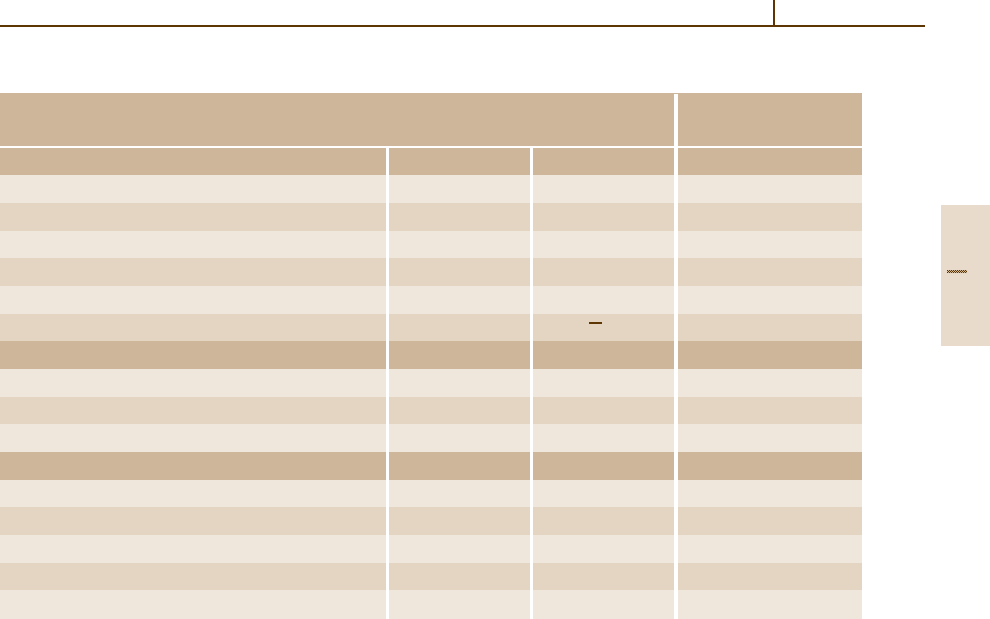Martienssen W., Warlimont H. (Eds.). Handbook of Condensed Matter and Materials Data
Подождите немного. Документ загружается.


442 Part 3 Classes of Materials
Table 3.2-9 Physical properties of oxides and oxide-based high-temperature refractories [2.4], cont.
IUPAC name
(synonyms
and common
trade names)
Theoretical
chemical
formula,
[CASRN],
relative
molecular mass
(
12
C =12.000)
Crystal system,
lattice parameters,
Strukturbericht,
symbol,
Pearson symbol,
space group,
structure type, Z
Density
(,kg m
−3
)
Electrical
resistivity
(ρ,µ cm)
Melting
point (
◦
C)
Thermal
conductivity
(κ, Wm
−1
K
−1
)
Specific heat
capacity
(c
p
,Jkg
−1
K
−1
)
Coefficient
of linear
thermal
expansion
(α,10
−6
K
−1
)
Titanium
dioxide
(rutile,
titania)
TiO
2
[13463-67-7]
[1317-80-2]
79.866
Tetragonal
a =459.37 pm
c =296.18 pm
C4, tP6, P4/mnm,
rutile type (Z = 2)
4240 10
19
1855 10.4 (|| c)
7.4 (⊥ c)
711 7.14
Uranium
dioxide
(uraninite)
UO
2
[1344-57-6]
270.028
Cubic
a =546.82 pm
Cl, cF12, Fm3m,
fluorite type (Z = 4)
10 960 3.8×10
10
2880 10.04 234.31 11.2
Yttrium
oxide
(yttria)
Y
2
O
3
[1314-36-9]
225.81
Trigonal
(hexagonal)
D5
2
, hP5, P3m1,
lanthana type (Z =1)
5030 – 2439 – 439.62 8.10
Zirconium
dioxide
(baddeleyite)
ZrO
2
[1314-23-4]
[12036-23-6]
123.223
Monoclinic
a =514.54 pm
b =520.75 pm
c =531.07 pm
α = 99.23
◦
C43, mP12, P2
1
c,
baddeleyite type
(Z = 4)
5850 – 2710 – 711 7.56
Zirconium
dioxide PSZ
(stabilized
with MgO)
(zirconia
> 2300
◦
C)
ZrO
2
[1314-23-4]
[64417-98-7]
123.223
Cubic
Cl, cF12, Fm3m,
fluorite type (Z = 4)
5800 – 6045 – 2710 1.8 400 10.1
Zirconium
dioxide TTZ
(stabilized
with Y
2
O
3
)
(zirconia
> 2300
◦
C)
ZrO
2
[1314-23-4]
[64417-98-7]
123.223
Cubic
Cl, cF12, Fm3m,
fluorite type (Z = 4)
6045 – 2710 – – –
Zirconium
dioxide TZP
(zirconia
> 1170
◦
C)
ZrO
2
[1314-23-4]
123.223
Tetragonal
C4, tP6, P4
2
/mnm,
rutile type (Z = 2)
5680 – 6050 7.7×10
7
2710 – – 10–11
Zirconium
dioxide
(stabilized
with
10–15%
Y
2
O
3
)
(zirconia
> 2300
◦
C)
ZrO
2
[1314-23-4]
[64417-98-7]
123.223
Cubic
Cl, cF12, Fm3m,
fluorite type (Z = 4)
6045 – 2710 – – –
a
Corrosion data in molten salts from [2.9].
Part 3 2.4

Ceramics 2.4 Oxide Ceramics 443
Table 3.2-9 Physical properties of oxides and oxide-based high-temperature refractories [2.4], cont.
Young’s
modulus
(E,GPa)
Flexural
strength
(τ,MPa)
Compressive
strength
(α,MPa)
Vickers
hardness
HV
(Mohs
hardness
HM)
Other physicochemical properties, corrosion resistance,
a
and uses
IUPAC name
(synonyms
and common
trade names)
248 – 282 340 800 – 940 (HM 7−7.5) White, translucent, hard ceramic material. Readily soluble in HF
and in concentrated H
2
SO
4
, and reacts rapidly with molten alkali
hydroxides and fused alkali carbonates. Owing to its good corrosion
resistance to liquid metals such as Ni and Mo, it is used in crucibles
for melting these metals. Titania is readily attacked under an inert
atmosphere by molten metals such as Be, Si, Ti, Zr, Nb, and Ta.
Titanium
dioxide
(rutile,
titania)
145 – – 600
(HM 6−7)
Used in nuclear power reactors in sintered nuclear-fuel elements
containing either natural or enriched uranium.
Uranium
dioxide
(uraninite)
114.5 – 393 700 Yttria is a medium-refractive-index, low-absorption material usable
for optical coating, in the near-UV (300 nm) to the IR (12 µm)
regions. Hence used to protect Al and Ag mirrors. Used for
crucibles containing molten lithium.
Yttrium
oxide
(yttria)
241 – 2068 (HM 6.5)
1200
Zirconia is highly corrosion-resistant to molten metals such as Bi,
Hf, Ir, Pt, Fe, Ni, Mo, Pu, and V, while is strongly attacked by the
following liquid metals: Be, Li, Na, K, Si, Ti, Zr, and Nb. Insoluble
in water, but slowly soluble in HCl and HNO
3
; soluble in boiling
concentrated H
2
SO
4
and alkali hydroxides and readily attacked by
HF. Monoclinic (baddeleyite) below 1100
◦
C, tetragonal between
1100 and 2300
◦
C, cubic (fluorite type) above 2300
◦
C. Maximum
service temperature 2400
◦
C.
Zirconium
dioxide
(baddeleyite)
200 690 1850 1600 Zirconium
dioxide PSZ
(stabilized
with MgO)
(zirconia
> 2300
◦
C)
– – – – Zirconium
dioxide TTZ
(stabilized
with Y
2
O
3
)
(zirconia
> 2300
◦
C)
200 – 210 > 800 > 2900 – Zirconium
dioxide TZP
(zirconia
> 1170
◦
C)
– – – – Zirconium
dioxide
(stabilized
10–15%
Y
2
O
3
)
(zirconia
> 2300
◦
C)
Part 3 2.4

444 Part 3 Classes of Materials
3.2.4.1 Magnesium Oxide
Table 3.2-10 lists the properties of the magnesium oxide
rich raw material used in the production of oxide ce-
ramics. MgO occurs rarely, as the mineral periclase,
but is abundant as magnesite (MgCO
3
) and dolomite
((Mg,Ca)CO
3
).
Magnesium oxide is mainly processed into a high-
purity single-phase ceramic material, in either porous
Table 3.2-10 Physical properties of MgO-rich raw materials used in the production of refractory ceramics [2.3]
Sintered Sintered Fused
Composition (wt%)
MgO doloma MgO
clinker clinker
MgO 96–99 39–40 97–98
Al
2
O
3
0.05 – 0.25 0.3–0.8 0.1–0.2
Fe
2
O
3
0.05 – 0.2 0.6–1.0 0.1–0.5
CaO 0.6 – 2.4 57.5 – 58.5 0.9–2.5
SiO
2
0.1 – 0.5 0.6–1.1 0.3–0.9
B
2
O
3
0.005 – 0.6 0.004 – 0.01
Bulk density 3.4–3.45 3.15 – 3.25 3.5
(g/cm
3
)
Grain porosity 2–3 5.5 – 7 0.5–2
(vol.%)
Table 3.2-11 Properties of MgO according to DIN EN 60672 [2.6]
Designation
C 820
Mechanical properties Symbol Units Porous
Open porosity vol. % 30
Density, minimum Mg/m
3
2.5
Bending strength σ
B
MPa 50
Young’s modulus E GPa 90
Electrical properties
Permittivity at 48–62 Hz ε
r
10
Thermal properties
Average coefficient of thermal expansion α
30−600
10
−6
K
−1
11–13
at 30–600
◦
C
Specific heat capacity at 30–100
◦
C c
p,30−600
Jkg
−1
K
−1
850 – 1050
Thermal conductivity λ
30−100
Wm
−1
K
−1
6–10
Thermal fatigue resistance (Rated) Good
or gas-tight form. Some properties of porous MgO are
listed in Table 3.2-11. The properties of MgO ceramics
that are of particular benefit in applications are their high
electrical insulation capability and their high thermal
conductivity. Typical examples of their application are
for insulation in sheathed thermocouples and in resistive
heating elements.
Part 3 2.4

Ceramics 2.4 Oxide Ceramics 445
3.2.4.2 Alumina
The properties of commercial grades of alumina (corun-
dum) are closely related to the microstructure. Pure
α-Al
2
O
3
is denser, harder, stiffer, and more refractory
than most silicate ceramics so that increasing the propor-
tion of the second phase in an alumina ceramic tends to
decrease the density, Young’s modulus, strength, hard-
ness, and refractoriness. Sintered alumina is produced
from high-purity powders, which densify to give single-
phase ceramics with a uniform grain size. Table 3.2-12
gives typical examples of properties of high-density alu-
mina, and Table 3.2-13 lists further properties of various
alumina ceramics.
Table 3.2-12 Typical properties of high-density alumina [2.3]
Al
2
O
3
content (wt%)
> 99.9 > 99.7
a
> 99.7
b
99 – 99.7
Density (g/cm
3
) 3.97 – 3.99 3.6 – 3.85 3.65 – 3.85 3.89 – 3.96
Hardness (GPa), HV 500 g 19.3 16.3 15–16 15–16
Fracture toughness K
IC
at room temperature (MPa m
1/2
) 2.8 – 4.5 – – 5.6–6
Young’s modulus (GPa) 366 – 410 300 – 380 300 – 380 330 – 400
Bending strength (MPa) at room temperature 550 – 600 160 – 300 245 – 412 550
Thermal expansion coefficient (10
−6
/K) at 6.5 – 8.9 5.4–8.4 5.4 – 8.4 6.4–8.2
200–1200
◦
C
Thermal conductivity at room temperature (W/mK) 38.9 28–30 30 30.4
Firing temperature range (
◦
C) 1600 – 2000 1750 – 1900 1750 – 1900 1700 – 1750
a
“Recrystallized” without MgO.
b
With MgO.
Table 3.2-13 Properties of Al
2
O
3
according to DIN EN 60672 [2.6]
Designation
C 780 C 786 C 795 C 799 Al
2
O
3
Al
2
O
3
Al
2
O
3
Al
2
O
3
Mechanical Symbol Units Alumina Alumina Alumina Alumina Alumina Alumina Alumina Alumina
properties
80–86% 86–95% 95–99% >99% <90% 92–96% 99% >99%
Open porosity vol. % 0.0 0.0 0.0 0.0 0 0 0 0
Density, min. Mg/m
3
3.2 3.4 3.5 3.7 > 3.2 3.4 – 3.8 3.5–3.9 3.75 – 3.98
Bending σ
B
MPa 200 250 280 300 > 200 230 – 400 280 – 400 300 – 580
strength
Young’s E GPa 200 220 280 300 > 200 220 – 340 220 – 350 300 – 380
modulus
Vickers HV 100 − − − − 12–15 12–15 12–20 17 – 23
hardness
Fracture K
IC
MPa
√
m − − − − 3.5–4.5 4–4.2 4–4.2 4–5.5
toughness
Alumina is widely applied both as an electronic
ceramic material and in cases where its nonelec-
tronic properties, such as fracture toughness, wear
and high-temperature resistance, are required. Some
typical applications are in insulators in electrotechni-
cal equipment; substrates for electronic components;
wear-resistant machine parts; refractory materials in
the chemical industry, where resistance against vapors,
melts, and slags is important; insulating materials in
sheathed thermocouples and heating elements; medi-
cal implants; and high-temperature parts such as burner
nozzles.
Part 3 2.4

446 Part 3 Classes of Materials
Table 3.2-13 Properties of Al
2
O
3
according to DIN EN 60672 [2.6], cont.
Designation
C 780 C 786 C 795 C 799 Al
2
O
3
Al
2
O
3
Al
2
O
3
Al
2
O
3
Thermal Symbol Units Alumina Alumina Alumina Alumina Alumina Alumina Alumina Alumina
properties 80–86% 86–95% 95–99% >99% <90% 92–96% 99% >99%
Electrical
properties
Breakdown E
d
kV/mm 10 15 15 17 10 15–25 15 17
strength
Withstand U kV 15 18 18 20 15 18 18 20
voltage
Permittivity at ε
r
− 8 9 9 9 9 9–10 9 9
48–62Hz
Loss factor tan δ
pf
10
−3
1.0 0.5 0.5 0.2 0.5 – 1.0 0.3–0.5 0.2 – 0.5 0.2 – 0.5
at 20
◦
C,
1kHz
Loss factor tan δ
1M
10
−3
1.5 1 1 1 1 1 1 1
at 20
◦
C,
1MHz
Resistivity ρ
20
Ω m 10
12
10
12
10
12
10
12
10
12
–10
13
10
12
–10
14
10
12
–10
15
10
12
–10
15
at 20
◦
C
Resistivity ρ
600
Ω m 10
5
10
6
10
6
10
6
10
6
10
6
10
6
10
6
at 600
◦
C
Ave. coeff. α
30−600
10
−6
K
−1
6–8 6–8 6–8 7–8 6–8 6–8 6–8 7–8
of thermal
expansion
at 30–600
◦
C
Specific heat c
p,30−600
Jkg
−1
K
−1
850 – 1050 850 – 1050 850 – 1050 850 – 1050 850 – 1050 850 – 1050 850 – 1050 850 – 1050
at 30–100
◦
C
Thermal λ
30−100
Wm
−1
K
−1
10 – 16 14–24 16–28 19–30 10–16 14–25 16–28 19–30
conductivity
Thermal (Rated) Good Good Good Good Good Good Good Good
fatigue
resistance
Typ. max. T
◦
C − − − − 1400 – 1500 1400 – 1500 1400 – 1500 1400 – 1700
application
temperature
Part 3 2.4

Ceramics 2.4 Oxide Ceramics 447
3.2.4.3 Al–O–N Ceramics
A class of variants of the ceramics related to alumina
is based on the ternary Al–O–N system, which forms
13 different compounds, some of which are polytypes
of aluminium nitride based on the wurtzite structure.
Table 3.2-14 lists some typical properties compiled from
various publications. Al–O–N ceramics have optical and
dielectric properties which make them suitable, for use,
for example, in windows for elctromagnetic radiation.
Table 3.2-14 Selected properties of Al
−
O
−
N ceramics [2.3]
Property Value
Refractive index at λ = 0.55 µm 1.77 – 1.88
IR cutoff 5.12 µm
UV cutoff 0.27 µm
Dielectric constant at 20
◦
C, 100 Hz 8.5
Dielectric constant at 500
◦
C, 100 Hz 14.0
Loss tangent at 20
◦
C, 100 Hz 0.002
Loss tangent at 500
◦
C, 100 Hz 1.0
Thermal conductivity at 20
◦
C 10.89 W m
−1
K
−1
Thermal expansion coefficient at 25–1000
◦
C 7.6×10
6
K
−1
Flexural strength at 20
◦
C 306 MPa
Flexural strength at 1000
◦
C 267 MPa
Fracture toughness 2.0–2.9MPam
1/2
3.2.4.4 Beryllium Oxide
Beryllium oxide (BeO, beryllia) is the only material
apart from diamond which combines high thermal-shock
resistance, high electrical resistivity, and high thermal
conductivity at a similar level. Hence its major ap-
plication is in heat sinks for electronic components.
BeO is highly soluble in water, but dissolves slowly
Table 3.2-15 Properties of BeO according to DIN EN 60672 [2.6]
Designation
C 810
Mechanical properties Symbol Units Beryllium oxide, dense
Open porosity vol. % 0.0
Density, minimum Mg/m
3
2.8
Bending strength σ
B
MPa 150
Young’s modulus E GPa 300
in concentrated acids and alkalis. It is highly toxic. It is
highly corrosion-resistant in several liquid metals, such
as Li, Na, Al, Ga, Pb, Ni, and Ir. Its maximum service
temperature is 2400
◦
C. Some properties are listed in
Table 3.2-15.
Part 3 2.4

448 Part 3 Classes of Materials
Table 3.2-15 Properties of BeO according to DIN EN 60672 [2.6], cont.
Designation
C 810
Electrical properties Symbol Units Beryllium oxide, dense
Breakdown strength E
d
kV/mm 13
Withstand voltage U kV 20
Permittivity at 48–62 Hz ε
r
7
Loss factor at 20
◦
C, 1 kHz tan δ
pf
10
−3
1
Loss factor at 20
◦
C, 1 MHz tan δ
1M
10
−3
1
Resistivity at 20
◦
C ρ
20
Ω m 10
12
Resistivity at 600
◦
C ρ
600
Ω m 10
7
Thermal properties
Average coefficient of thermal expansion at α
30−600
10
−6
K
−1
7–8.5
30–600
◦
C
Specific heat capacity at 30–100
◦
C c
p,30−100
Jkg
−1
K
−1
1000 – 1250
Thermal conductivity λ
30−100
Wm
−1
K
−1
150 – 220
Thermal fatigue resistance (Rated) Good
3.2.4.5 Zirconium Dioxide
Zirconium dioxide (ZrO
2
), commonly called zirconium
oxide, forms three phases, with a monoclinic, a tetrag-
onal, and a cubic crystal structure. Dense parts may be
obtained by sintering of the cubic or tetragonal phase
only. In order to stabilize the cubic phase, “stabilizers”
such as MgO, CaO, Y
2
O
3
,andCeO
2
are added.
An important class of zirconium dioxide ceram-
ics is known as partially stabilized zirconia (PSZ),
Table 3.2-16 Physical properties reported for commercial grades of partially stabilized zirconia (PSZ) [2.3]
Mg-PSZ Ca-PSZ Y-PSZ Ca/Mg-PSZ
wt% stabilizer 2.5–3.5 3–4.5 5 – 12.5 3
Hardness (GPa) 14.4
a
17.1
b
13.6
c
15
Fracture toughness K
IC
at room temperature (MPa m
1/2
) 7–15 6–9 6 4.6
Young’s modulus (GPa) 200
a
200 – 217 210 – 238 −
Bending strength (MPa) at room temperature 430 – 720 400 – 690 650 – 1400 350
Thermal expansion coefficient 9.2
a
9.2
b
10.2
c
−
(10
−6
/K) at 1000
◦
C
Thermal conductivity at room temperature (Wm
−1
K
−1
) 1–2 1–2 1–2 1–2
a
2.8% MgO.
b
4% CaO.
c
5% Y
2
O
3
.
and Table 3.2-16 gives typical property data for several
different grades. Further properties of PSZ are listed
in Table 3.2-17. It should be noted that, as with most
ceramic materials, the K
1C
data depend on the test
method applied, and all the other mechanical proper-
ties are strongly affected by the microstructure (grain
size, stabilizer content, etc.) and further variables such
as temperature and atmospheric conditions.
Part 3 2.4

Ceramics 2.4 Oxide Ceramics 449
Table 3.2-17 Properties of PSZ according to DIN EN 60672 [2.6]
Designation
PSZ
Mechanical properties Symbol Units Partially stabilized ZrO
2
Open porosity vol. % 0
Density, minimum Mg/m
3
5–6
Bending strength σ
B
MPa 500 – 1000
Young’s modulus E GPa 200 – 210
Vickers hardness HV 100 11 – 12.5
Fracture toughness K
IC
MPa
√
m
5.8 – 10.5
Electrical properties
Permittivity at 48–62 Hz ε
r
22
Resistivity at 20
◦
C ρ
20
Ω m 10
8
–10
13
Resistivity at 600
◦
C ρ
600
Ω m 10
3
–10
6
Thermal properties Symbol Units Partially stabilized ZrO
2
Average coefficient of thermal expansion at 30–600
◦
C α
30−1000
10
−6
K
−1
10 – 12.5
Specific heat capacity at 30–100
◦
C c
p,30−1000
Jkg
−1
K
−1
400 – 550
Thermal conductivity λ
30−100
Wm
−1
K
−1
1.5 – 3
Thermal fatigue resistance (Rated) Good
Typical maximum application temperature T
◦
C 900 – 1600
Part 3 2.4

450 Part 3 Classes of Materials
3.2.4.6 Titanium Dioxide, Titanates, etc.
Titanium dioxide (TiO
2
)iswidelyusedinpowderform
as a pigment and filler material and in optical and
catalytic applications. Technical ceramics made from
titanium dioxide or titanates have the characteristic
Table 3.2-18 Properties of titanium dioxide, titanates etc. according to DIN EN 60672 [2.6]
Designation
C 310 C 320 C 330 C 331 C 340 C 350
Titanium Magnesium Titanium Titanium Bismuth Perovskites,
dioxide titanate dioxide dioxide titanate, middle ε
r
Mechanical chief with other with other basic
properties Symbol Units constituent oxides oxides
Open porosity vol. % 0.0 0.0 0.0 0.0 0.0 0.0
Density, minimum Mg/m
3
3.5 3.1 4.0 4.5 3.0 4.0
Bending σ
B
MPa 70 70 80 80 70 50
strength
Breakdown strength E
d
kV/mm 8 8 10 10 6 2
Withstand voltage U kV 15 15 15 15 8 2
Permittivity at ε
r
40 – 100 12–40 25–50 30–70 100 – 700 350 – 3000
48–62 Hz
Loss factor tan δ
1k
10
−3
6.5 2 20.0 7 − −
at 20
◦
C, 1 kHz
Loss factor tan δ
1M
10
−3
2 1.5 0.8 1 5 35.0
at 20
◦
C, 1 MHz
Resistivity ρ
20
Ω m 10
10
10
9
10
9
10
9
10
9
10
8
at 20
◦
C
Thermal
properties
Average coefficient α
30−600
10
−6
K
−1
6–8 6–10 − − − −
of thermal expansion
at 30–600
◦
C
Specific heat capacity c
p,30−100
Jkg
−1
K
−1
700 – 800 900 – 1000 − − − −
at 30–100
◦
C
Thermal λ
30−100
Wm
−1
K
−1
3–4 3.5–4 − − − −
conductivity
feature that their permittivity and its temperature coef-
ficient can be adjusted over a wide range. Furthermore,
they have a low loss factor. Some properties are listed in
Table 3.2-18.
Part 3 2.4

Ceramics 2.5 Non-Oxide Ceramics 451
3.2.5 Non-Oxide Ceramics
The non-oxide ceramics comprise essentially borides,
carbides, nitrides,and silicides. Like oxideceramics they
have two kinds of uses, which frequently overlap: appli-
cation of their physical properties and of their refractory
high-temperature properties. Extensive accounts can be
found in [2.1–3,8, 10].
3.2.5.1 Non-Oxide High-Temperature
Ceramics
The two dominating design variables to be considered
for high-temperature materials are hardness and thermal
conductivity as a function of temperature. Figure 3.2-2
8000
6000
4000
2000
0
0 400 800 1200
TiB
2
+W
T(°C)
Vickers hardness (kg /mm
2
)
Diamond
CBN
Si
3
N
4
– TiC or –Ta
2
Si
B
4
C
SiB
6
B
6
O
Si
3
N
4
Cr–C
WC
SiB
4
Al
2
O
3
ZrO
2
SiC
IVA,VA–Me–C,IVA–Me–B
VA–Me–(C,N)
a)
Fig. 3.2-2a,b Temperature dependence of (a) the hardness and (b) the thermal conductivity of ceramic materials in
comparison with diamond and cubic boron nitride (CBN) [2.3]
gives a survey. It is obvious that borides and carbides are
superior to most oxide ceramics. Depending upon the
microstructure, SiC has a higher hardness than that of
β-Si
3
N
4
, but it decreases somewhat more rapidly, with
increasing temperature. Both Si
3
N
4
and SiC ceramics
possess a high thermal conductivity and thus excellent
thermal-shock resistance.
3.2.5.2 Borides
Borides and boride-based high-temperature refractories
are treated extensively in [2.2, 3, 10]. Some properties
are listed in Table 3.2-19.
200
180
160
140
120
100
80
60
40
20
0
0 200 400 600 800 1000 1200
Thermal conductivity (W/m k)
T(°C)
SiB
4
SiB
6
ZrO
2
SiO
2
B
6
O
Si
3
N
4
B
4
C
ZrC
NbC
HfC
TiC
Al
2
O
3
SiC
hot pressed
660 – 1350
Diamond
AlN, 0% O
SiC pure
AlN, 4% O
ZrB
2
TiB
2
WC
b)
Part 3 2.5
